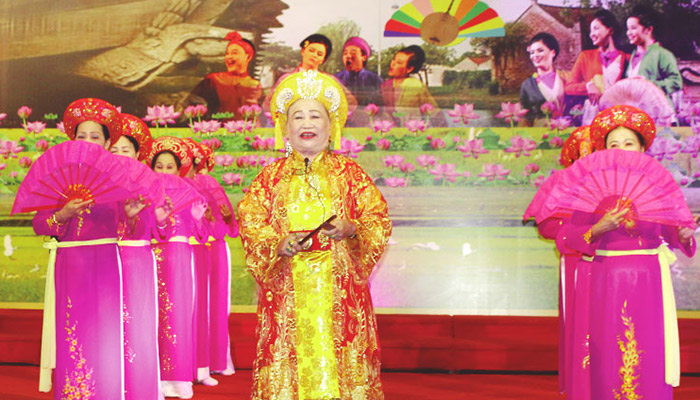The intangible cultural beauty of Ha Nam
In Ha Nam province, intangible culture is not only an indispensable part of people's daily lives but also a solid foundation of the unique cultural identity of this land. Over the centuries, intangible culture in Ha Nam has existed and developed, closely associated with community life and consciousness. What is special is that these cultural beauties are not only historical heritage but also an endless source of inspiration for modern people, and are an inseparable part of the country's reputation and unique cultural beauty. Ha Nam.

First, Quyen Son mom singing, a special form of folk music and dance found only in Quyen Son village, Thi Son commune, Kim Bang district, Ha Nam province, is not only a precious cultural heritage but also is a symbol of respect and deep gratitude of the villagers to national hero Ly Thuong Kiet. Singing mile is not simply music but also a form of honouring and expressing affection for the historical and cultural past of Quyen Son village. Through hundreds of years of development, Quyen Son singing has attracted attention and admiration from artisans and tourists around the world. With more than 1,000 years of history, more than 38 melodies have been collected and passed down through generations. Each melody has its own unique characteristics and fully reflects the economic, social and religious life of the ancient villagers. The rustic and rustic nature of singing miles has made it close and easy to understand for farmers. Without being complicated, mile singing is not only a form of music but also a profound cultural symbol of the Quyen Son people. As a respectful offering to the gods, mim singing is only performed at sacred locations such as temple doors and temple grounds. Through the efforts of subsequent generations, Quyen Son mile singing has not only been preserved but also spread and recognized internationally. From a local cultural heritage, singing miles has become a symbol of Vietnamese culture, arousing people's pride and contributing to clarifying the national culture before the world.

Second, the Lai Len singing and dancing festival is a ritual to worship the Gods that takes place at Noi Chuoi communal house, now Noi Do village, Bac Ly commune, Ly Nhan district, in the early days of the new year. The Lai Len dance and singing lineup includes 12 Lai girls, young girls aged 15 to 18, dressed in red shirts and black pants, accompanied by props such as white towels, betel baskets, bamboo swords, and five-coloured flags. In addition, there are 8 boys playing the role of king's servants, wearing white pants and silk belts decorated with lotus flowers. The festival takes place from the first day of Tet to the end of the third day of Tet, with a total of 32 melodies, each one with different content and scenes. Lai len dance and singing are performed for 3 days, with Lai ladies having to perform up to 22 melodies on the third day. Except for taking place during the three festival days, Lai Len dancing and singing is also a unique traditional cultural expression of Noi Chuoi, which the people here strive to preserve and pass on to the next generation.

Finally, the Willow Doi Festival represents the traditional culture of Ha Nam province. Every year, on the 5th day of the first lunar month, in Lieu Doi village, Liem Tuc commune, Thanh Liem district, Ha Nam province, a wrestling festival takes place to honour the merits of a young man named Doan, who bravely fought in the war. fight to protect the homeland. The festival attracts the participation of Lieu Doi villagers and neighbouring villages with martial arts traditions. In particular, women are also invited to participate and have the opportunity to show off their talent with weapons such as knives, clubs, swords, punches... no less "men". The festival process begins with the Saint Procession Ceremony, in which the Saint is carried from the temple to the place where offerings are held. Offerings to the saint include oan products, bananas and a cup of tea. Then, the Fire Ceremony took place, when a large fire was lit to commemorate the magical blue flame from the fiery sword that heaven gave to Lieu Doi land. Next is the Sword Giving and Peach Scarf Ceremony, to commemorate the boy named Doan receiving the magic sword and peach scarf. The Gathering Flag Dance Ceremony, also known as "Heaven and Man Ky Battle", is one of the notable activities, with participants carrying square red flags, moving from both sides of the holy palanquin to the middle of the dance. according to the drum signal. Next is the Thanh Dong Ceremony, when the sound of the drum and bell rings from dawn and all the temples in the area respond. Finally, comes the wrestling match, with the wrestlers dressed only in loincloths and shirtless. Traditional martial arts pieces such as armpits, ribs, gong pieces, beef pieces... make viewers anxious to watch. Malicious acts such as jaw hooking and genital squeezing are strictly prohibited, and violations will be punished. The Lieu Doi Wrestling Festival is not only an opportunity to demonstrate martial spirit and solidarity, but also an opportunity to contribute to enriching the Vietnamese national cultural identity and enhancing national pride.
With the preservation and development of the people, intangible culture in Ha Nam continues to shine and create the unique identity of this land. Every cultural beauty, from traditional festivals to religious ceremonies, are wonderful moments, filled with meaning and historical value. At the same time, these intangible cultural beauties also contribute to enriching and increasing the appeal of cultural tourism in Ha Nam, attracting the attention of tourists and contributing to creating a beautiful image of the region. This land is on the tourist map of Vietnam.










